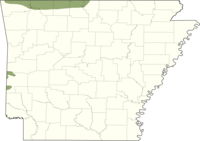Description
This small, ⚠ fossorial species is highly variable in ⚠ dorsal coloration and patterning. Common morphs include solid, striped, partially banded, and fully banded. Solid individuals are usually some shade of tan or brown. Striped individuals are similar to solid individuals, but with a reddish or brownish longitudinal stripe. Partially banded individuals are similar to solid or striped individuals, but with one (sometimes a few) black neck bands. Fully banded individuals have black bands that run the length of the snake. ⚠ Ventral coloration is plain cream. ⚠ Dorsal scales are smooth.
Due to the wide range of variability, this species--especially solid individuals--may be easily confused with several other ⚠ fossorial species. An examination of the belly, which is plain cream in Ground Snakes, can start the process of elimination. Flat-headed Snakes have a salmon pink belly and Red-bellied Snakes typically have a red belly. The Earthsnake sister-species, Rough Earthsnake and Western Smooth Earthsnake, have strongly or weakly ⚠ keeled scales, whereas the Groundsnake has smooth scales.
Habitats
This is a species primarily of the arid Southwest. In Arkansas, which represents the extreme eastern portion of its range, this species is a glade dweller and may be discovered by overturning rocks.
Habits and Life History
This secretive borrower presumably follows an activity pattern similar to other snakes, with most activity occurring in spring. In other parts of its range, the species is known to mate in both spring and fall, with eggs being laid in the summer.
Prey and Hunting Techniques
This species is known to eat a variety of arthropod prey, including spiders, scorpions, and centipedes. Prey is presumably found by active foraging and, when found, is subdued in a grab-and-eat fashion.
Temperament and Defense
This species will not bite if handled gently. It has little in the way of defense other than its small size and secretive nature. It is known to death-feign if disturbed.
Conservation
This species is considered rare by the Arkansas Natural Heritage Commission. In 2005, after nearly 50 years without a single record in the state, 3 specimens turned up in 3 separate counties! Despite these recent records, the status of this species in the state remains largely unknown.
State Distribution and Abundance

| This species is found only in the most extreme northwestern counties in the state and in Polk County. With only a handful of specimens ever to have been verified in Arkansas, the abundance of this species in the state is presumed to be low.
|
Gallery
⚠ (:flickrgallery:)
Contributors
- kaptainkory December 10, 2006, at 06:55 PM (Original Contributor)
Bibliography
- Behler, J. L., and F. W. King. 1979 (1987). The Audubon Society Field Guide to North American Reptiles and Amphibians. 3rd ed. Alfred A. Knopf, New York. 743 pp.
- Conant, R., and J. T. Collins. 1998. A Field Guide to Reptiles and Amphibians of Eastern and Central North America. 3rd ed., Expanded. Houghton Mifflin Co., Boston. 616 pp.
- Irwin, K. J. 2004. Arkansas Snake Guide. Arkansas Game and Fish Commission Pocket Guide. 50 pp.
- Trauth, S. E., H. W. Robison, and M. V. Plummer. 2004. Amphibians and Reptiles of Arkansas. University of Arkansas Press, Fayetteville. 421 pp.
Discussion
< Western Ratsnake | Snake | Flat-headed Snake >
